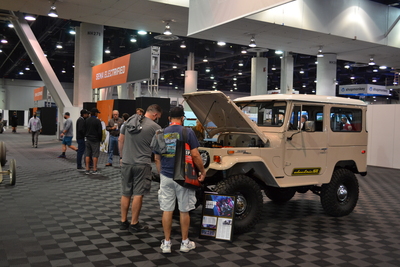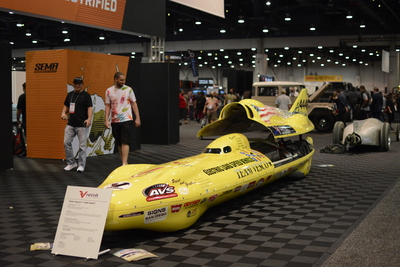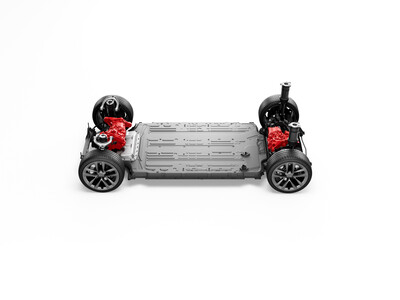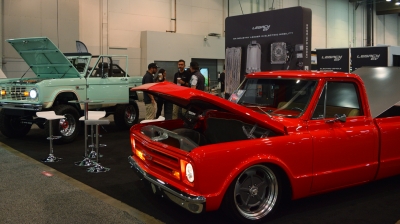By Douglas McColloch

Dozens of EV conversions were on display at SEMA Electrified—the 2021 SEMA Show section dedicated to this growing sector. Among the vehicles on display was this ’70 Land Cruiser from Electric GT. It featured a plug-and-play e-Crate power system that mated directly to the OE bellhousing.
At the 2021 SEMA Show, electrification projects could be found in virtually every hall, with conversion platforms including ’60s sedans and musclecars, early Broncos and square-body Chevys, Bonneville racers, sand rails and Baja prerunners. While still a small fraction of the hundreds of builds at the Show, their presence on the Show floor heralds the beginning of a new era in the specialty-equipment aftermarket—and one that holds great promise for aspiring builders and customizers looking to leverage the new technology to create new revenue streams.
A recent SEMA Education webinar, “Swapping Electric Drivetrains into Classic Vehicles,” reviewed the basics of the electric vehicle (EV) drivetrain-swap process, with helpful tips to guide builders who are still familiarizing themselves with the new componentry. Moderated by Michael Bream, founder and CEO of EV West, an EV parts and conversion shop that has been in operation since 2009, the webinar included usable tips on the actual swap process along with discussions of subjects to consider before the build even gets under way.
Before the Build: First Steps
As with many conventional vehicle builds, the first thing to do is determine the feasibility of the project, followed by a rough cost estimate. The prospective builder should be able to determine which vehicles make the best candidates for conversions and be able to create rough estimates of range and power based on the EV system the builder intends to use. Also important is the ability to determine those factors that affect range and efficiency.
“You don’t want to spend too much time on this,” Bream advised. “You just want to determine the limitations of doing a conversion on a classic car and what the customer’s expectations are for range, power and cost. If your customer wants a 400-mi. range or a $10,000 conversion—well, that’s not possible.”
The customer needs to be apprised of what can be realistically achieved and what it will cost. Bottom line: EV conversions are still rather pricey, and a basic single-motor, 100-mi., 100hp package on a smaller, lightweight platform—an older Porsche or MG, for example—will run around $20,000, with parts and labor roughly split 50/50. Performance builds, such as for racing, can cost upward of $100,000.
Whether running internal-combustion engine (ICE) or EV propulsion systems, some laws of automotive physics remain immutable—and in this case, weight is the enemy of range.
“The first, most popular question you’re going to get is, ‘How far can I drive?’” Bream noted, “Since we’re talking about classic vehicles, the limiting factor is almost always vehicle weight. With classic vehicles, the most important to thing to think about is GVWR. In the case of classics, we’re talking about a vehicle that was designed 40–50 years ago, and it won’t give the kind of weight ratings that a modern late-model vehicle will have.”

Anyone doubting the performance potential of EVs would be wise to consider this Tesla-powered electric racer from reVolt Systems. It set a world land-speed record at Bonneville in September 2021 with a combined top speed of 353 mph. It was exhibited at last year’s SEMA Electrified.
Typically, older vehicles can only accommodate 400 to 800 lbs. of additional weight, and that will affect battery selection, depending on the vehicle platform.
Space is another important consideration.
“Installing batteries in vehicles is much like hauling cinder blocks around town,” Bream analogized. “They’re big, they’re heavy, they’re square and not rounded.”
Builders will generally use CAD programs or even cardboard mockups of the battery box to determine space considerations, weight balance and other safety factors. Customers are also well advised to stay up to date on the latest developments in EV technology in order to make the best, most informed choices.
“The EV space is a moving target, and you want to make sure that you don’t make a purchasing decision right on the cusp of some new battery technology coming out,” Bream said. “With the introduction of factory EV trucks, we’re going to see higher-power and higher-capacity batteries and higher-power motors that will be available to us.”
Bream also advised builders to consider using a complete, integrated used OE battery assembly for reasons of simplicity and cost—the type of thing you could pull out of a Tesla or a Mustang Mach-E.
“Those are becoming quite popular, and they provide a great cost advantage,” he said. “A Tesla small drive unit is inexpensive and affordable.” The complete running drive for such a system (reduction gears, differential, etc.) is available for as low as $3,300.
Finally, engine-dependent vehicle functions need to be considered.
“When you pull out the gas engine, you lose your pulley drive for things such as hydraulics, your A/C compressor and your heater core, so you need to determine ahead of time which of those systems are going to be eliminated and which will be needed,” Bream, reminded. “Other EV-specific options should also be discussed, such as an onboard inverter so you can run power tools or lights or camping equipment. Once you have a high-voltage pack in your vehicle, even if you’re running a 12-volt inverter, you can keep that 12-volt system charged from a high-voltage battery and have many kilowatt-hours of energy available to you.”
EV Conversion: Four Builders’ Goals
Once the preliminaries are agreed to, the actual conversion can take place. Since EV builds pose their own unique challenges, Bream suggested following four basic guidelines for a successful conversion.
Build for safety. This starts with ensuring proper weight distribution. Since the EV conversion can potentially involve adding several hundred pounds to the vehicle, you want to look at where the balance is, Bream advised.

EV conversions are generally pricey, with $20,000 considered a baseline build for a small, lightweight vehicle platform. However, budget-minded consumers can economize by looking into acquiring complete used OE drive assemblies. A complete pre-owned Tesla short drive unit can be had for around $3,000, which can shave thousands of dollars off the cost of the build. Photo courtesy: Tesla
“You definitely want to weigh the car before you start removing components from it and know what kind of weight distribution you are trying to target,” he said, since pronounced changes in weight distribution can affect brake bias, suspension cycling and a host of other performance parameters.
Easy access to charging also needs to be factored in.
“Your typical customer is going to be charging his vehicle after work—most likely at night when it’s dark outside—so the charger should be well-lit and easily accessible,” he said. “A fuel filler door with an LED light inside it makes it easier and safer for the customer to charge the car.”
Bream strongly advised ensuring that drive-away protection is integrated into the charging function so that when the charger is plugged into the vehicle, all vehicle controls are disabled and the vehicle cannot be driven.
“Modern inverters have functionality for this, so this absolutely needs to be done,” Bream noted.
User inputs—throttle, braking and the like—should be programmed to be as predictable as inputs on an ICE vehicle.
“You can program the slew rate, the acceleration rate and the regenerative braking rate to mimic what a combustion engine does, and that’s really what we want to deliver—no surprises,” he said.
Before returning the vehicle to the owner, all new onboard systems should be tested to their limits.
“Don’t assume that you’re going to go into a thermal cutback at 50°C,” Bream said. “Try to obtain that temperature and actually see when a thermal cutback happens. Drive the vehicle to its estimated maximum range and see where the voltage is to make sure you still have usable voltage in the car.”
Additionally, charge times should be observed to see if they fall within their expected limits, and the battery management system (BMS) should also be tested for upper and lower voltage ranges.
Build for serviceability. Bream advised placing all serviceable items, such as fuses and cables, in a sealed, centralized location. Use plenty of labels with all available information regarding relevant data such as fuse specifications and electrical current limits. Imagine that you were going to service a vehicle you didn’t perform the EV conversion on, Bream said, and include all the data you would need to perform
a service.
“Keep all your files up-to-date, including the vehicle schematic and the latest software updates,” he said, “Additionally, take photos that can be used later. This has come in handy because we’ve had cars go in for a remote service, and the technicians there can use those photos as points of reference.”
Consistent labeling and color coding for all cables and wires should be considered essential.
“Use high-vision universal orange for all of your high-voltage components, and red and black for your 12-volt stuff,” Bream said, warning against mixing up color schemes. “Stay visually consistent.”
Build for aesthetics. The customer may think he wants a complete overhaul, but it’s important for the builder to retain all original parts until after the conversion is completed.
“It’s very common for people to want to pull out their V8 engine and get that stinky thing out of their garage,” Bream said. “But then they might realize later that they need that lower bracket for the power steering pump, or they need to measure that ‘magic number’ distance from the crankshaft to the bellhousing flange, so there’s a lot of reasons why you want to keep all of your original parts, and there are even some creative things you can do with them later.”
In the same vein, use period-correct switches and hand controls wherever possible.
“In old Volkswagens, we like to use old single-speed wiper switches and repurpose them for functions such as regeneration rate or to select your charge rates,” Bream noted, adding that little things like heater levers can be reused to activate the vehicle’s new electric heater by adding a micro-switch, so repurposing as much as possible can help preserve the vehicle’s period look—and keep build costs manageable.
Also keep the interior clutter-free to retain the vehicle’s vintage look.
“Hide all of the nonessential displays,” he said. “Some EV motor systems come with a pretty dated-looking display that might give you diagnostic codes and error codes that you don’t need on a continuous basis.”
He suggests hiding the display module in the glovebox or under the dash, where a technician can access it but where nobody can see if they’re looking at the vehicle from the outside.

Legacy EV will be one of the growing number of EV-conversion and related companies to exhibit at the 2022 SEMA Show.
“You want to keep the interior looking stock and not like some science experiment,” he advised. “And hide the EV components. Nobody wants to see the BMS or the battery. Generally speaking, it gives people anxiety to see all that cabling. If you look at any modern EV, there are no visuals. There’s nothing to see under the hood and nothing to see in the trunk, and the vehicle manufacturers do that for a reason. They know that seeing these complex systems can induce anxiety in people, so hide as much of that stuff as you can.”
Build for power. You can’t really “tune” an electric powertrain like you can an ICE version, but there are a few things that can help builders optimize the power that’s available to them. That starts with understanding how the power is delivered—the programmable slew rate, the vehicle’s acceleration rate and the amount of torque that’s available throughout the power band. This is especially important if the vehicle is retaining stock components such as brakes, driveshafts, U-joints or axle shafts, since they can pose weak links in the drivetrain if they are subjected to torque loads that they were never designed to handle.
“You want to make sure your vehicle’s systems can handle the extra torque,” Bream reminded.
EV Conversion Sources: Who’s Exhibiting This Year
The number of EV conversion companies is small at present, but more players are entering the space each year as consumer demand increases. Here is a brief rundown of EV-conversion and related companies that were scheduled to be exhibiting at the 2022 SEMA Show as of press time. Visit www.SEMAShow.com for future updates.
AEM’s EV division doesn’t offer conversion kits per se but a whole roster of products to facilitate EV swaps, including Vehicle Control Units, Power Distribution Units (PDUs), CAN converter modules, and digital dash displays. (310-484-2322, www.aemev.com)
The Atom Drive EV system from Ampere EV utilizes a homebuilt Advanced Control System to support a full compliment of EV components sourced from third parties such as Tesla and Cascadia. Customers can build their own system by choosing from a range of batteries, chargers, wiring options and LED screens. (888-984-7601, www.ampereev.com)
APP EV Systems, a division of Advanced Performance Parts, designs, builds and sells turnkey EV conversion kits for classic cars that are engineered to OE specifications. Applications for Porsche 911s, BMW E9s and Chevrolet C2 Corvettes, among others, are available later this year and early 2023. (360-935-1228, appevsystems.com)
Autel Energy now offers the MaxiCharger home 40- and 50-amp AC plug-in wallbox Level 2 EV chargers, smart chargers that are compatible with all EV and hybrid plug-in vehicles. The chargers offer adjustable charging up to 40–50 amps, depending on model. (855-288-3587, www.autelenergyus.com)
Electric GT offers turnkey E-Crate conversion systems to replace four-, six, or eight-cylinder ICE vehicles. (619-717-6009, www.electricgt.com)
Hypercraft USA offers turnkey electric drive systems for everything from one-off builds to scaled commercial production. (208-670-7289, www.hypercraftusa.com)
Legacy EV has an EV conversion kit for virtually any gas-powered vehicle manufactured since 1900. Legacy also offers a variety of individual components for EV conversions, and educational programs for technicians as well. (602-518-3223, legacyev.com)
Motorcadd specializes in EV conversions for medium- and heavy-duty trucks and vans. (352-223-1723, www.motorcadd.com)
Scorpion EV converts Mk4 roadsters from Factory Five Racing to full EV power using a Tesla Model S drivetrain. All the customer needs to do, the company says, is select their roadster’s color, and Scorpion will handle the rest. (www.scorpion-ev.com).





